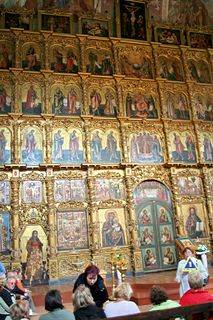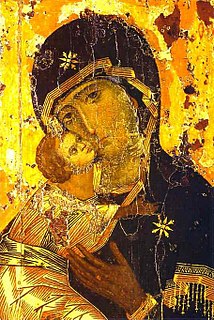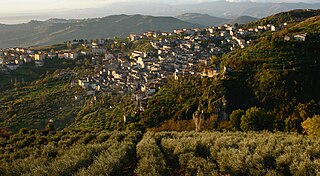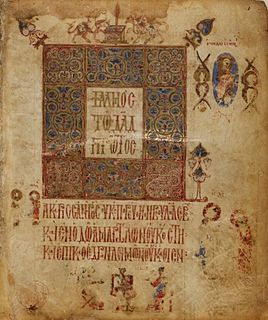
The Eastern Orthodox Church, officially the Orthodox Catholic Church, is the second-largest Christian church, with approximately 200–260 million baptised members. It operates as a communion of autocephalous churches, each governed by its bishops in local synods, although roughly half of Eastern Orthodox Christians live in Russia. The church has no central doctrinal or governmental authority analogous to the Bishop of Rome, but the Ecumenical Patriarch of Constantinople is recognised by all as primus inter pares of the bishops. As one of the oldest religious institutions in the world, the Eastern Orthodox Church has played a prominent role in the history and culture of Eastern and Southeastern Europe, the Caucasus, and the Near East.

Saint John of Damascus ; also known as John Damascene and as Χρυσορρόας / Chrysorrhoas was a Syrian monk and priest. Born and raised in Damascus c. 675 or 676, he died at his monastery, Mar Saba, near Jerusalem on 4 December 749.

In Eastern Christianity an iconostasis is a wall of icons and religious paintings, separating the nave from the sanctuary in a church. Iconostasis also refers to a portable icon stand that can be placed anywhere within a church. The iconostasis evolved from the Byzantine templon, a process complete by the fifteenth century.

The Byzantine Rite, also known as the Greek Rite or Constantinopolitan Rite, is the liturgical rite used by the Eastern Orthodox Church, the Greek/Byzantine Catholic churches, and in a modified form, Byzantine Rite Lutheranism. Its development began during the fourth century in Constantinople and it is now the second most-used ecclesiastical rite in Christendom after the Roman Rite.

A templon is a feature of Byzantine churches consisting of a barrier separating the nave from the sacraments at the altar.

Religious images in Christian theology have a role within the liturgical and devotional life of adherents of certain Christian denominations. The use of religious images has often been a contentious issue in Christian history. Concern over idolatry is the driving force behind the various traditions of aniconism in Christianity.

The Theotokos of Vladimir, also known as Our Lady of Vladimir, Vladimir Mother of God, or Virgin of Vladimir is a medieval Byzantine icon of the Virgin and Child. In 1169 Andrei Bogolyubsky sacked Kyiv, and, after plundering the city, stole much religious artwork, including a Byzantine "Mother of God" icon which was transferred to Vladimir. It is one of the most venerated Orthodox icons and a fine and early example of the iconography of the Eleusa (tenderness) type, with the Christ child snuggling up to his mother's cheek. The Theotokos is regarded as the holy protectress of Russia. The icon is displayed in the Tretyakov Gallery, Moscow in a functioning church in the grounds of the museum. Her feast day is June 23rd o.s. / July 6th n.s. Even more than most famous icons, the original has been copied repeatedly for centuries, and many copies have considerable artistic and religious significance of their own.

The Intercession of the Theotokos or the Protection of Our Most Holy Lady Theotokos and Ever-Virgin Mary, is a feast of the Mother of God celebrated in the Eastern Orthodox and Byzantine Catholic Churches. The feast celebrates the protection afforded the faithful through the intercessions of the Theotokos. In the Slavic Orthodox Churches it is celebrated as the most important solemnity besides the Twelve Great Feasts and Pascha. The feast is commemorated in Eastern Orthodoxy as a whole, but by no means as fervently as it is in Russia, Belarus and Ukraine. It is not a part of the ritual traditions of, and therefore is not celebrated by, the Oriental Orthodox Churches or Western Rite Orthodoxy. Yet the feast is perfectly consistent with the theology of these sister churches. It is celebrated on October 14.

Lungro is a town and comune (municipality) in the Province of Cosenza in the Calabria region of Italy.

The Feast of Orthodoxy is celebrated on the first Sunday of Great Lent in the liturgical calendar of the Eastern Orthodox Church and of the Byzantine Rite Eastern Catholic Churches. The Feast is kept in memory of the final defeat of iconoclasm and the restoration of the icons to the churches.

Khorúgv, is a religious banner used liturgically in the Eastern Orthodox and Eastern Catholic Churches.

Typikon is a liturgical book which contains instructions about the order of the Byzantine Rite office and variable hymns of the Divine Liturgy.

The Epitaphios is a Christian religious icon, typically consisting of a large, embroidered and often richly adorned cloth, bearing an image of the dead body of Christ, often accompanied by his mother and other figures, following the Gospel account. It is used during the liturgical services of Good Friday and Holy Saturday in the Eastern Orthodox Churches, as well as those Eastern Catholic Churches, which follow the Byzantine Rite. It also exists in painted or mosaic form, on wall or panel.

Byzantine Iconoclasm refers to two periods in the history of the Byzantine Empire when the use of religious images or icons was opposed by religious and imperial authorities within the Eastern Church and the temporal imperial hierarchy. The "First Iconoclasm", as it is sometimes called, existed between about 726 and 787. The "Second Iconoclasm" was between 814 and 842. According to the traditional view, Byzantine Iconoclasm was started by a ban on religious images by Emperor Leo III and continued under his successors. It was accompanied by widespread destruction of images and persecution of supporters of the veneration of images. The Western church remained firmly in support of the use of images throughout the period, and the whole episode widened the growing divergence between the Eastern and Western traditions in what was still a unified church, as well as facilitating the reduction or removal of Byzantine political control over parts of Italy.

A Hodegetria, or Virgin Hodegetria, is an iconographic depiction of the Theotokos holding the Child Jesus at her side while pointing to Him as the source of salvation for humankind. The Virgin's head usually inclines towards the Child, who raises his hand in a blessing gesture. In the Western Church this type of icon is sometimes called Our Lady of the Way.
Hierotopy is the creation of sacred spaces viewed as a special form of human creativity and also a related academic field where specific examples of such creativity are studied. The concept and the term were developed in 2002 by Russian art-historian and byzantinist Alexei Lidov. Hierotopy accounts for the ways in which a vast array of media are used to organize sacred spaces. As an academic field, it spans the disciplines of art history, archeology, cultural anthropology, ethnology and religious studies, but it possesses an object of study and a methodology of its own. It differs from the phenomenology of the sacred insofar as it focuses on historical examples of hierotopic projects, that is, projects establishing a medium of communication between the mundane and the sacred. Though related with religious mysticism, hierotopy deals first and foremost with forms of conscious, creative activity.

Alexei Mikhailovich Lidov is a Russian art historian and byzantinist, an author of the concepts hierotopy and spatial icon, member of the Russian Academy of Arts.

The Theodore Psalter is an illustrated manuscript and compilation of the Psalms and the canticles, or Odes from the Old Testament. "This Psalter has been held in the British Library since 1853 as Additional 19.352," wrote Princeton Art History professor Charles Barber in his first essay that is a companion to the Theodore Psalter E-Facsimile. Barber called the Psalter, "One of the richest illuminated manuscripts to survive from Byzantium."
During the Byzantine Empire, Byzantine art was centered on a Christian society based in Constantinople after the fall of Rome. Religious or holy icons were used throughout Byzantine Art in many different forms: mosaics, paintings, statues and illuminated manuscripts. Monasteries helped produce many of the illuminated manuscripts devoted to religious works using the illustrations to highlight specific parts of text, a saints' martyrdom for example, while others were used for devotional purposes similar to icons. These religious manuscripts were most often made possible at request of patrons and were used for private worship but also gifted to churches to be used in services.














